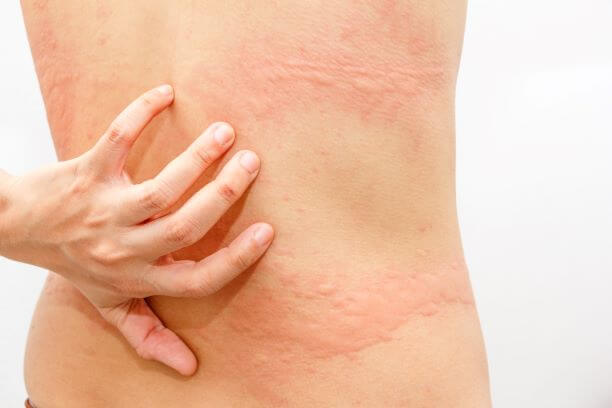Hives are a common condition that cause itching and skin irritation. According to Dr. Kathleen Ellison of U.S. Dermatology Partners in Fairfax, Virginia, “Because hives often develop as an allergic response, more people may be combatting this condition during the summer months when there are allergens in the air and growing around us in plant life and especially from poison oak, ivy, and sumac. Learning to avoid your allergens and preparing to treat hives right away can significantly reduce your discomfort.” If you often experience itchy, painful hives, you’ll want to read this blog about the common causes of hives, how you can soothe them at home, and when it’s time to call the U.S. Dermatology Partners team for professional treatment.
What are Hives?
Hives are red, itchy, painful bumps (wheals) on the skin that are usually small, but they may grow to several inches in diameter. The medical term for hives is urticaria. In most cases, the hives are small round or ovular bumps, but the smaller individual bumps may connect forming a larger clump of hives. In most cases, hives clear up within 24 hours, but new hives may develop as older ones clear up. For most people, hives clear fully within a week. In rare and serious instances, a deep welt beneath the skin may occur along with hives. This condition is called angioedema, and it often causes swelling and inflammation in the face that can be very dangerous. If you notice large lumps or swelling beneath the skin’s surface in conjunction with your hives, you should seek emergency medical care, especially if the swelling impedes your vision or threatens to block the airway.
What Causes Hives?
Hives commonly occur as a result of an allergic reaction. Individuals can experience hives as an allergic response to specific foods, medications, insect bites, animal dander, or contact with an irritating substance (latex, chemicals, etc.). During the spring and summer, hives are commonly caused by pollen and plant allergens, especially contact with poison oak, ivy, and sumac. In addition to allergy-related causes, hives may also occur due to:
- Infections (including bacterial and viral infections)
- As a symptom of systemic health conditions like lupus or thyroid disease
- Overexposure to the elements (sunlight, heat, cold, humidity, dryness)
- Pressure or friction on the skin
- Chemical or irritant contact
- Stress
How Can I Soothe Hives at Home?
Hives will usually clear up quickly on their own, and they don’t typically require professional treatment. To relieve discomfort from hives at home, you should take the following steps:
- Stay cool – Wear loose-fitting clothing and avoid overheating
- Apply cold compresses – Place cool cloths, ice cubes, or frozen veggies directly on hives to relieve itch, inflammation, and pain
- Use anti-itch cream – Apply an over the counter anti-itch cream like calamine lotion regularly
- Moisturize – Use a fragrance-free and hypoallergenic moisturizer several times a day to keep the affected area from drying out and cracking
- Avoid triggers – Learn the foods, allergens, medications, weather, and other sources that cause hives and do your utmost to avoid these
- Reduce stress – Worry, anxiety, and stress are common causes of hives, so relieving stress or avoiding stressors can be helpful
Can I Prevent Hives?
If you frequently break out in hives or suffer from chronic hives, your dermatologist will partner with you to determine the underlying causes or triggers that lead to flareups of this skin condition. By learning your triggers and removing them from your immediate surroundings, you can typically prevent flareups of hives or minimize the side effects. The triggers of hives typically fall into one of the following categories:
- Foods – Any food or drink can cause an allergic response including hives, but eggs, nuts, and shellfish are common triggers. In most cases, you will notice hives appearing within an hour of consuming the triggering food. If you have a latex allergy, foods like bananas, chestnuts, and kiwis may trigger hives that can begin developing 12 to 24 hours after eating the food.
- Additives & Preservatives – Foods, drinks, cosmetics, cleaning products, and even medications can contain added chemicals, colorings, preservatives, and fragrances that lead to hives developing within 24 hours of exposure.
- Medications – Antibiotics, ibuprofen, and a whole range of prescription and over the counter medications can lead to hives. To make things even more complicated, medication-related hives can appear minutes, hours, days, or years after first taking a medication. It’s best to report any medications you take regularly when trying to determine your hive triggers.
- Weather & Environmental Factors – Heat, cold, dryness, humidity, prolonged sun exposure, rain, sleet, and other weather and environmental factors can lead to hives.
- Pressure, Friction & Vibration – Tight clothing, prolonged friction, movement, or vibration can all irritate and inflame skin leading to hives.
- Allergens – Plants, animals, and chemicals often cause an allergic response on the skin that typically begins within minutes of contacting the allergen or irritant.
When Should I Visit a Dermatologist for Hive Treatment?
You should visit a dermatologist to treat hives in the following situations:
- Your hives don’t clear up within a week
- Your hives are extremely painful or inhibit movement
- You notice deep bumps or lumps below the skin especially on the face
- You have chronic or prolonged hives that don’t respond to self-care
Your dermatologist can provide oral and topical prescription medications to help relieve the immediate symptoms like itching and inflammation. We may also offer injected medications to treat severe, acute hives. If your hives don’t respond to treatment, we may want to run more tests to rule out systemic illnesses that can cause chronic hives. If the underlying cause of your hives is a severe allergy, we may recommend including an allergist as part of your healthcare network to help you get the allergic response under control.
Ready to Get Started Treating Hives at U.S. Dermatology Partners?
If you need help healing hives or getting symptoms under control, the U.S. Dermatology Partners team is here to help. With safe social distancing and increased infection control measures in please, we are once again offering in-office appointments for non-emergency patients. You can complete a scheduling request form to get started.
If you would still prefer to limit your contact, we are happy to continue offering online, teledermatology appointments. Simply complete our teledermatology request form to schedule your online appointment. Contact a location near you if you have questions or want to learn more.
Find a location near me
or


